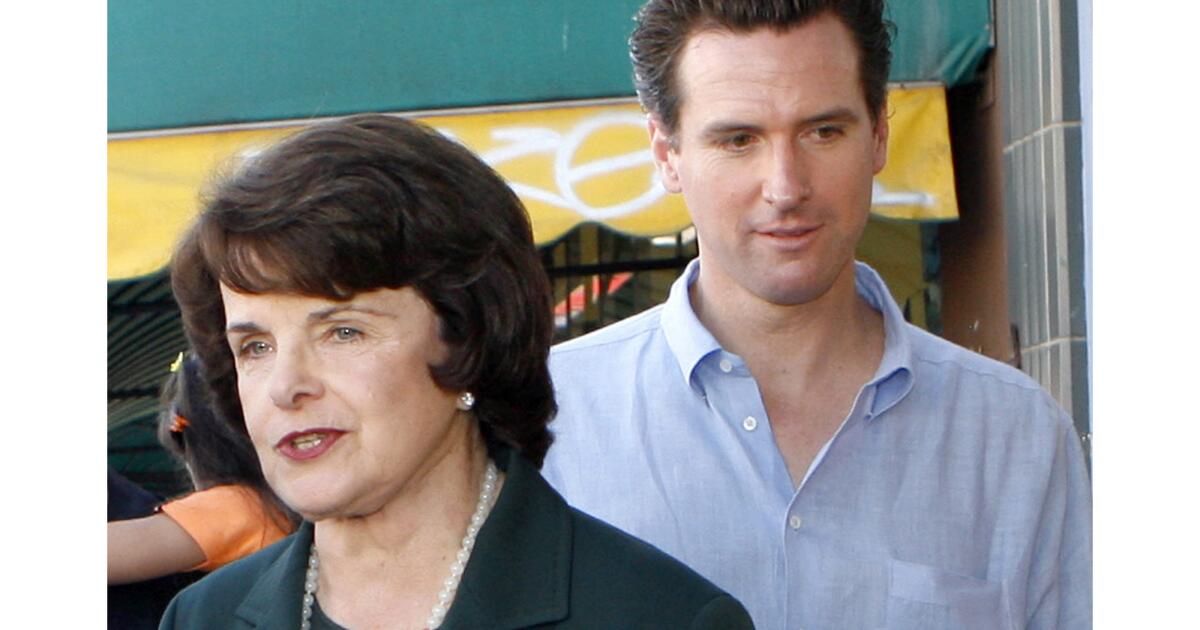The death of California’s venerable Democratic U.S. Sen. Dianne Feinstein turns attention to Gov. Gavin Newsom, who now faces the politically challenging task of appointing someone to fill her seat.
The moment also offers a powerful and rare opportunity for the Democratic governor to shape California’s representation at the highest levels of government and deepen his influence on the future of the state Democratic Party.
Newsom in 2020 appointed then-Secretary of State Alex Padilla as the the state’s first Latino senator, filling the vacancy when then-Sen. Kamala Harris was elected vice president, whom California voters had elected in 2016 to a six-year term. He tapped Shirley Weber as California secretary of state that same year and chose Rob Bonta as California attorney general in 2021.
In a statement about her death, Newsom called Feinstein “a powerful, trailblazing US Senator; an early voice for gun control; a leader in times of tragedy and chaos.”
“But to me, she was a dear friend, a lifelong mentor, and a role model not only for me, but to my wife and daughters for what a powerful, effective leader looks like,” Newsom said. “She was a political giant, whose tenacity was matched by her grace. She broke down barriers and glass ceilings, but never lost her belief in the spirit of political cooperation.”
Speculation about whom Newsom would chose to replace Feinstein heightened as her health declined and Californians lost confidence in her ability to serve. Feinstein announced last year that she would not run for another term.
The governor said that he would abide by a pledge he made to appoint a black woman to the next vacant seat after he tapped Padilla to fill the Harris seat three years ago. The 100-member Senate does not include a Black woman, a void left when Harris vacated her California seat in 2021.
Newsom has indicated he has several people in mind, but has not divulged any names.
The Democratic governor of California told NBC’s Chuck Todd earlier this month that he would make an “interim appointment” to the position if a seat in the Senate became vacant, signaling his intent to put a caretaker in the role.
Appointing someone who does not intend to run for the seat in the 2024 election would allow the governor to avoid stepping on the toes of the Democratic candidates vying to replace her and the interest groups backing them.
“I don’t want to get involved in the primary,” Newsom said. “It would be completely unfair to the Democrats that have worked their tail off. That primary is just a matter of months away. I don’t want to tip the balance of that.”
Washington University Political Science Professor Steven Smith said Newsom has to be careful not to “alienate a whole swath of California Democrats” with his decision.
“If he has an interest in the presidency, he wants his whole party in California behind him,” Smith said of the governor’s political future. “And so I can see why he would then want a caretaker because then he wouldn’t be choosing among the live candidates for the spot.”
With pending judicial nominations in the Senate Judiciary Committee, Democrats could push Newsom to fill the seat quickly.
“Having a Democrat in that seat is really a high priority and any delay could be a pretty serious problem,” Smith said.
Several high-profile Democratic candidates have emerged to succeed Feinstein.
Democratic Reps. Adam B. Schiff of Burbank and Katie Porter of Irvine lead in the polls and the money race ahead of Rep. Barbara Lee (D-Oakland).
Newsom has faced pressure to appoint Lee, the only Black woman in the race and a politician who has represented Oakland and other parts of the Bay Area at the state and congressional level for decades. Those calls are expected to intensify in light of Feinstein’s death.
Lee criticized Newsom’s decision to make only an “interim” appointment: “Black women deserve more than a participation trophy. We need a seat at the table.”
Wendy Schiller, an associate professor of public policy at Brown University and expert on the Senate, said if Newsom holds to his commitment to appoint a placeholder that person would be a lame duck and struggle to get anything accomplished.
“If you want a really strong advocate for the state of California for the next a year or a year and a couple months, do you really want somebody who’s just a placeholder?” Schiller said. “You know, I mean, I understand you have a lot of seats in the house, but the house is majority Republican. So if you’re California, you probably want somebody who might have an interest in running for the seat for a full term.”
At this point, it would be difficult for Newsom to do anything other than what he promised.
“Changing his mind would make him seem indecisive and cause an uproar as he introduces himself to a national audience,” said Rose Kapolczynski, a Democratic strategist who ran Barbara Boxer’s Senate campaigns.
The opportunity for a governor to fill two Senate seats is rare in California history.
California Gov. Earl Warren appointed William Knowland in 1945 and Thomas Kuchel in 1953. Gov. Pat Brown also appointed two senators, though their appointments lasted a matter of days following their election, according to historian Alex Vassar with the California State Library.
Similar to Padilla’s appointment, the person Newsom taps to fill the job will serve until after the November election.
Reporter Sarah D. Wire in Washington and Sacramento Bureau Chief Laurel Rosenhall contributed to this report.
This story originally appeared on LA Times

